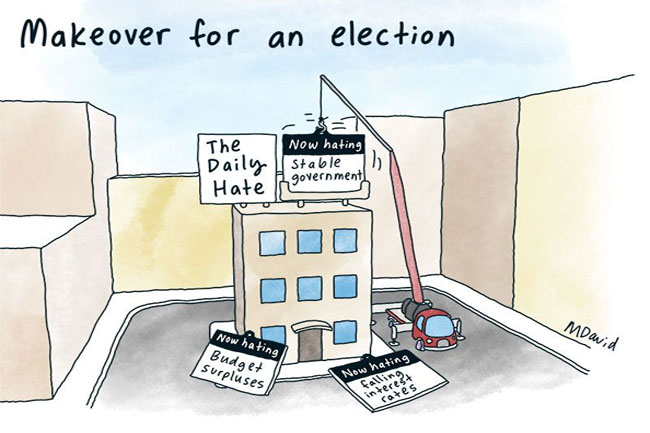Almost everything the Turnbull Government says about the economy, employment and their priorities is refuted by the evidence.
That is certainly true of Thursday’s statements on the jobs situation as revealed by the Australian Bureau of Statistics (ABS).
Minister for education and training Simon Birmingham would have us believe:
‘ABS labour force figures can jump around from month to month’ and ‘today’s data continue to reflect a resilient Australian labour market’ and the Coalition’s plan is ‘to strengthen the economy and stimulate further jobs growth.’
The opposite of all three claims is the truth. This is clear when we compare data over the last 41 months with earlier periods of Coalition and Labor management. It becomes even starker when we compare Australia with the rest of the world.
The current remarkable boom is boosting production, exports, productivity, economic growth and company profits across the globe. Most workers worldwide are enjoying increasing work hours, higher wages and better conditions.
Australia now enjoys robust annual growth, booming minerals exports and a record trade surplus. Companies are recording record revenues and profits. Yet jobs are being lost, conditions are being pared away and wage rises are at record lows.
Employment to population
This ratio has steadily increased through Australia’s post-war economic growth. It clicked over 61% in 2005 during the Howard period and stayed above that level during the final Howard years and throughout Labor’s term. It fluctuated through the global financial crisis (GFC) but never dropped below 61% — despite the worst recession in 80 years.
Now the global economy is surging, this should be rising steadily. It isn’t. Since the Coalition came to office in September 2013, it has been below 61% for 27 of their 41 months, including the last six months. This reverses a trend which began in the 1940s.
@deniseshrivell Ironic highest unemployment level since GFC was not front and centre on #Insiders today. Lest we further embarrass our political master
— Rod Moffatt (@Ozlandscapes) March 19, 2017
Employment to population for men
This ratio has been at 62.2% for the last two months and for three of the last six. The last time it was this low was in the early 1990s recession. It had been steadily increasing since then. Until now.
People unemployed
From highs close to a million in the early 1990s, before the restructure of the economy took effect, the total number of people unemployed has steadily declined. It dropped below 720,000 in 1998 where it stayed for the next 15 years. By the end of the GFC in 2013, levels above 720,000 seemed gone forever.
But within months of the hapless Joe Hockey becoming treasurer, it was back above 720,000 again. Shortly after his 2014 budget, it blew out to 762,000. It peaked above 790,000 before Hockey was eventually sacked.
High levels have remained, despite replacing the prime minister and the treasurer. The jobless has been above 720,000 for 31 of the last 34 months. In February it was 748,123.
Full-time to total jobs
This ratio fell in March 2016 to the lowest in history — 68.6%. It tumbled further for the next two months and then fell below 68% for the first time last September. The January number was a new record low of 67.7%. February’s is the third lowest ever at 67.99%.
Hours worked per person per month
Hours worked have been below 85.4 for the last 12 months, the worst outcome since the early 1990s.
This is the best indicator of real paid work, as IA has claimed for more than a year. This takes into account all variables – part-time work, full-time work and population – and enables accurate comparisons through time.
Unemployment up.
— Bill Shorten (@billshortenmp) March 16, 2017
Underemployment at record highs.
Wages growth at record lows.
Turnbull's plan? Give big biz a tax cut & workers a pay cut.
This fell to 83.89 in December 2014, the lowest level since March 1994. It then recovered slightly but slumped again in February to 84.17, the third lowest since 1994.
Hours worked have been below 85.4 for the last 12 months, the worst outcome since the early 1990s.
Underemployment
The number of workers who have some work but are willing – in many cases desperate – to work more hours has exploded. It clicked over one million after Joe Hockey’s first budget and last week reached a new record 1,114,558 workers. That’s up as a percentage of the labour force from 7.8% when the Coalition took office to an all-time high 8.7%.
Job participation
Job participation dropped to 64.4% last September and October, the lowest since 2006. It is now 64.6%.
Job participation for men fell below 71% for the first time in Australia’s history in December 2013. It has fallen to fresh lows five times since, reaching in January an all-time low 70%. In February it was 70.3%.
Job participation for youth aged 15 to 19 fell to a record low 52% last October. It is now 53.3%. For the last five months, it has remained below 53.4%. That has happened twice in Australia’s history – under Abbott and now under Turnbull.
Australia's unemployment rate rises to 5.9% with 6,400 jobs lost in February https://t.co/zFUsorFe4V jobs & growth the lib way #auspol
— Sassy Leo (@Loud_Lass) March 16, 2017
Jobs for women
Women’s unemployment is now back above 6%. It has been 5.7% or higher for the last 39 months. The last time that occurred was 2001 to 2004.
Through Labor’s entire period, including the global financial crisis, this never exceeded 5.7%.
Comparisons with other countries
Australia’s jobless rate has always been among the world’s lowest. Until now. In 2013, Australia’s ranking among the 34 developed countries comprising the Organisation for Economic Cooperation and Development (OECD) was seventh. By the end of 2015, after two failed Joe Hockey budgets, ranking had slipped to 13th.
Now it is an all-time low 16th.
Policy framework
These figures strongly suggest the structure of Australia’s jobs market has dramatically changed in the last three years — to the profound disadvantage of workers.
This observation is consistent with other structural changes — to the tax system, to wages, to gas and electricity supply, to budget priorities, to foreign ownership of land and utilities, to financial regulation and to the acceptance of workplace fatalities. All these indicate a shift in privilege, income and wealth from the poor and middle to the rich and very rich.
So we should never believe Minister for Education and Training Simon Birmingham or other Coalition ministers when they say they are:
‘ ... creating the right policy frameworks that will facilitate stronger jobs growth, so that all Australians can take advantage of new, emerging job opportunities.’
The opposite is true.
You can follow Alan Austin on Twitter @AlanTheAmazing.
Australia's #unemployment rate rose from 5.7% to 5.9% in the month of February after 6,400 jobs were lost overall. pic.twitter.com/XEr4Me0EFn
— ABC News 24 (@ABCNews24) March 16, 2017

This work is licensed under a Creative Commons Attribution-NonCommercial-NoDerivs 3.0 Australia License
Nailed it!
— Darren West (@DarrenWestMLC) December 30, 2016
The truth about jobs in Australia — that you won't read in the MSM.
Look past the spin.https://t.co/R2BksvANV6 @IndependentAus
Monthly Donation
Single Donation
@QandA @terrimbutler Hope we get some discussion on " jobs & growth " and the latest 5.9% unemployment,& historic underemployment figures
— Rowan (@FightingTories) March 19, 2017
Get the facts. Subscribe to IA for just $5.











